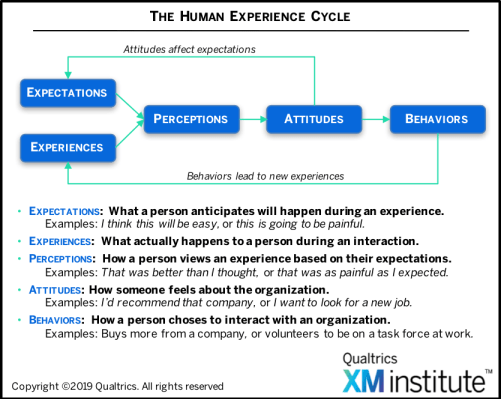As you think about your experience management (XM) efforts, it’s important to understand how people flow through the experiences in their lives — as customers, employees, patients, fans, citizens, students, etc. To help deepen that understanding, I’ve created a simple model, the Human Experience Cycle (HxC). As you can see in the chart below, the HxC is made up of five elements:
- Experiences: What actually happens to a person during an interaction.
- Expectations: What a person anticipates will happen during an experience. This can be heavily influenced by previous interactions.
- Perceptions: How a person views an experience based on their expectations, which are viewed across three dimensions: Success (can they achieve their goals), Effort (how easy or hard is it), and Emotion (how does it make them feel).
- Attitudes: How someone feels about the organization. These are somewhat persistent mindsets, such as I like that company, I don’t like my job, or I love that brand.
- Behaviors: How a person choses to interact with an organization, which is heavily. influenced by that person’s attitudes. If I like the company, then I may look at other product offerings they have.

Here are some implications of the HxC:
- Experiences are in the eyes of the beholder. How someone feels about an experience (their perception) is based on their expectations along with the actual experience. So the exact same experience can lead to different perceptions for different people. That’s why you need to think about the expectations you’re setting prior to an experience and consider delivering different experiences based on people’s expectations.
- Experiences are judged by the emotions they create. Our memories aren’t like video cameras, they’re more like an Instagram account where we take pictures whenever we feel strong emotions, and then we judge that experience in the future based on reviewing those pictures. That’s why it’s critical to proactively think about which emotions an experience is likely to generate, since those are the elements which will most drive perceptions.
- Attitudes are important... Many organizations measure attitudes (e.g., a relationship Net Promoter Score) as part of their overall metrics program. This is an important area to understand because it represents an accumulation of multiple perceptions and can often be a leading indicator of behaviors. That’s why many successful XM programs prioritize their efforts around the experiences that most highly affect attitudes.
- …But behaviors are the goal. The success or failure of an organization is driven by what people actually do, their behaviors. Over time, you need to make sure that the attitudes you’re measuring have an actual impact on the behaviors you really care about — is NPS really driving future purchases? or is our employee engagement measurement predicting attrition? If not, look for different attitudinal measurements that are more predictive of those important behaviors.
The bottom line: Align your efforts around the Human Experience Cycle.





